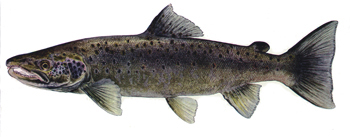February 23, 2009
Not Just A Fish Story: The Color Of Salmon

By Michael D. Shaw
On January 23, 2009, USA Today ran a story entitled “Something fishy? Counterfeit foods enter the U.S. market.” The piece covered the practice of economic adulteration, whereby something cheap can masquerade as something more expensive. Some examples are maple syrup diluted down with sugar and water; extra virgin olive oil that is mostly soybean oil; and honey diluted with beet or cane sugar.
The article also touched on seafood, calling fish “the most frequently faked food Americans buy…”
When Consumer Reports tested 23 supposedly wild-caught salmon fillets bought nationwide in 2005-2006, only 10 were wild salmon. The rest were farmed. In 2004, University of North Carolina scientists found 77% of fish labeled red snapper was actually something else. Last year, the Chicago Sun-Times tested fish at 17 sushi restaurants and found that fish being sold as red snapper actually was mostly tilapia.
Did you notice how salmon were conflated with the other fish? After all, whether wild-caught or farm-raised, salmon is still salmon. The cited Consumer Reports article launched into a tendentious argument regarding possible health benefits of wild over farm-raised, although there are plenty of studies that dispute this notion. Certainly, the predominant wild species—Chum, Pink, Steelhead, and Sockeye—tend to be more expensive than the farm-raised (95% of which is Atlantic salmon–Salmo salar). As such, mislabeling, prohibited under federal law, would be a consumer rip off.
Where USA Today went wrong was in attempting to provide a criterion to tell the difference between wild and farm-raised salmon. The article notes that “Farmed salmon gets its coloring from dyes added to food pellets the fish are fed, while wild salmon gets it from the plankton they eat.”
That statement is incorrect in several key areas.
The pigment astaxanthin is an essential component of the diet of salmon, wild or otherwise. In the wild, the fish get it from krill, and when farm-raised the astaxanthin is part of their feed. Besides changing the color of the flesh, this carotenoid is also a vital nutrient, antioxidant and pro-vitamin A source that influences the growth and survival of young salmon.
There are more than 600 carotenoids in nature, giving plants and animals pigmentation in varying colors ranging from yellow to red.
In fact, astaxanthin is a pigment, not a dye. The basic difference between dyes and pigments is their solubility. Whereas pigments are insoluble and must be used as dispersions, dyes are soluble colorants.
But USA Today compounded its error when it quoted Spring Randolph, of the FDA’s Office of Seafood: “When you cook it, the wild salmon retains its color, and in the aquaculture salmon, the color tends to leak out.” Assuming Randolph’s statement is true—which it most definitely is not—being able to discern the origin of the salmon only after cooking it is hardly useful to the consumer.
Moreover, the idea that astaxanthin—contained in specialized cells called chromatophores—can somehow “leak out” of animal flesh is ludicrous, and betrays an ignorance of basic biology.
As demand for healthy food alternatives has increased, interest in fish has grown as well. Since the natural ocean environment cannot produce sufficient fish to match the increased demand, aquaculture, the cultivation of marine and freshwater finfish and shellfish, is one way to satisfy the demand—at reasonable prices.
In a peak catch year, wild salmon can supply about one-third of the worldwide demand for salmon. While wild fisheries have seasonal availability, as well as limitations on the amount of fish caught, salmon ocean farms produce large amounts of consistent, high quality salmon year-round.
Aquaculture is one of the fastest growing food production sectors in the world and forms a large part of the global solution to environmentally sustainable food production. Plus, aquaculture is good for the human ecology. Aquaculture operations have rejuvenated former low-income areas of Maine, Chile, and Canada.
In Maine, the operations are based in economically-challenged Washington and Hancock counties. Maine’s coast is extensive, boasting 3,800 acres of fishable waters and several hundred miles of shoreline. Salmon farming operations exist on fewer than 0.003% of these acres—a fraction of the 1,275 acres occupied by pleasure boat marinas in the state.
The Maine aquaculture industry accounts for $82 million in direct sales, the majority of which come from salmon ocean farming. Sales per employee are twice the average of all other Maine businesses, and worker compensation surpasses the state average.
Aquaculture: Environmentally sustainable, producing more food at lower cost, along with good jobs. What’s not to like?

